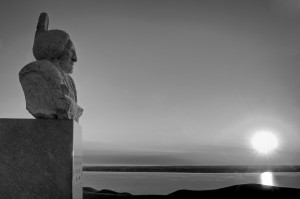By Katie Hunhoff
We thought we’d broached every possible topic in 30 years of publishing South Dakota Magazine, but we found an altogether new subject for our Sept/Oct issue. Where are the burial sites of the great Indian leaders of the 19th century?
Paul Higbee, a Spearfish writer, led our effort to find the graves. He also wrote about the history and tradition of Indian burials. We discovered that the graves generally lie in Christian cemeteries because many Lakota and Dakota people converted to Christianity. But elements of traditional religion were still practiced, including a “release of the soul” rite which occurs a year after death.
Indian country cemeteries don’t always have the manicured appearance that you might see in other communities. Sometimes the grass is long, the stones are leaning and the road is rutted. The difference is partly because traditional Native American culture calls for remembering the dead through ceremony, not at a physical place.
However, many of the Lakota and Dakota leaders’ graves are within sight of the Missouri River. And there is a feeling of reverence and solemnity at every site, no matter the height of the grass.
Sitting Bull’s grave, just west of Mobridge, is perhaps the most picturesque. A bust created by Crazy Horse sculptor Korczak Ziolkowski marks the site, which is high above the Missouri River.
The graves of Struck-by-the Ree, Iron Nation and Gall are also near the Missouri. Struck-by-the-Ree is buried south of Marty on the Yankton Sioux Reservation. Gall, a contemporary of Sitting Bull who fought with him at the Battle of the Little Bighorn, is also buried west of Mobridge.
Spotted Tail was a Sicangu leader famous for his wit. He complained on one occasion about the constant relocations of his community, telling authorities, “I think you had better put the Indians on wheels and then you can run them about wherever you wish.” His gravesite is near Rosebud.
Red Cloud’s grave is near the Red Cloud School, west of Pine Ridge. A Catholic church and a cultural center also share space on the beautiful campus built by Jesuit missionaries in the 1880s. Red Cloud led a deadly campaign to burn military posts, but he eventually realized that U.S. forces were too strong to overcome. After that, he accepted the reservation life while continually fighting federal efforts to reduce tribal lands. “Red Cloud lived to age 88, dying in 1909 when the Indian wars had been romanticized in American memory,” writes Higbee. “Yet his name still sent shivers down the spines of some elderly Army veterans.”
We also traveled to Manderson, home of the Lakota holy man Nicholas Black Elk. He is buried in the Catholic cemetery, across the highway from St. Agnes Church. A deeply rutted road leads to the fenced, hilltop cemetery. Waist-high prairie grasses make it difficult to find the simple black marker. Sage, a purifying herb in Lakota culture, grows atop the grave.
Higbee notes that the story behind Crazy Horse’s burial is known, but only by a few people. After he was fatally bayonetted at Camp Robinson in Nebraska, family members took the body. “Certain people are aware of his remains, says Donovin Sprague, a descendent and author. “It’s a very guarded secret and no one would ever reveal anything.”
Check out the magazine article for more history, photos and directions to the graves. Higbee also offers tips on cemetery etiquette.
We know we missed the burial sites of some important Native American leaders. We’ll keep looking and learning. That’s the whole idea behind publishing South Dakota Magazine.

